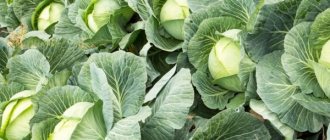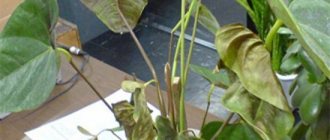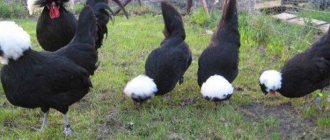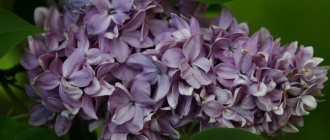4637
Lilac is a plant beloved by many, which decorates urban and rural areas at the end of spring with lush blooms and fills the air with a specific sweet aroma. Modern gardeners for their home gardens try to choose decorative varieties of lilac that can withstand unfavorable conditions. All this applies to the Sensation lilac variety, the photo and description of which rarely leaves anyone indifferent.
Variety Sensation
Characteristics of the variety
The lilac variety Sensatsiya is a tall deciduous shrub with an annual growth of about 50 cm and a maximum height of up to 3 meters. The bark and leaves have the same rich green color. The leaf blades have an ovoid shape characteristic of this culture, but are larger than those of other representatives and can reach up to 12 cm in length.
Flowers appear on the bush a year after planting. They are also large in size (up to 2.2 cm in diameter), have a tubular structure, consist of 4 petals and form into large panicle inflorescences up to 8 cm wide and about 20 cm long. The flowering is lush and very dense, while the flowers bloom not simultaneously, but one after another. Each of them blooms for 9–12 days, the lifespan of one inflorescence is 13–19 days, and the entire bush can bloom for a month.
Related article:
Dried flowers that you can grow yourself
The fruits are two-leaf elongated capsules, inside of which there are 2–4 winged seeds. They are formed after the end of the flowering period (mid-June) and ripen throughout the summer.
Lilac Sensation is widely used in landscape gardening and garden plots. Suitable for single plantings and creating hedges, especially in combination with white flowering bushes.
Grows on slightly acidic or neutral soils
Description of lilac Sensations - photos, planting and care:
| general characteristics | Tall bush. The shoots are densely branched and directed upward. |
| Size | Height up to cm: 200-300 Diameter up to cm: 150-200 |
| Flowers | Purple-red, with white border |
| Leaves | Wide-elliptical |
| The soil | Undemanding to soil conditions |
| Illumination | Photophilous, but tolerates slight shading |
| Winter hardiness | Winter hardiness is high. USDA zone 3 |
| 1. Lilac Sensation (lat. Syringa vulgaris Sensation) |
Properties:
- a young but popular variety from France;
- tall bush up to 4 m in height and 3 m in width;
- an upright bush with green, even shoots;
- leaves are large, dark green, dense;
- buds dark purple;
- purple flowers with an original white frame;
- 2.2 cm in diameter, large, aromatic;
- petals are rounded with slightly raised edges;
- pyramidal inflorescences with densely packed flowers;
- blooms profusely from May to June;
- the color of the inflorescences is resistant to fading and retains color almost until the end of flowering;
- actively growing, annual growth is 20-30 cm;
- lends itself well to pruning, does not require special skills;
- The landing site is preferably illuminated and protected from gusts of wind;
- high winter hardiness;
- resistant to heat and air pollution;
- has a pleasant sweet aroma;
- the variety is perfect for creating hedges and decorating lawns
Properties:
- lilac grows in moderately moist fertile deep soil;
- prefers loam;
- does not tolerate stagnant water;
- grows on slightly acidic or neutral soils;
- should be planted in sunny places with good drainage;
- dig a 50x50 cm voluminous hole with steep walls;
- fill with fertile soil;
- maintain a distance of at least 3 m between plants;
- The planting site should be chosen protected from the wind, but open to sunlight;
- common lilac does not tolerate acidified soil; wood ash or lime will help deoxidize it;
- in the shade the bush loses density and stops blooming;
- the best time for transplantation is the end of August, the beginning of September;
- in the shade additional fertilization is required
Properties:
- an adult plant is fed 2 times;
- in early spring - organic fertilizers are applied;
- after flowering, the root system is fed with complex fertilizers and mineral additives;
- responds well to foliar feeding with microelements;
- in the first years of life it needs abundant watering;
- needs annual pruning;
- sanitary and molding are carried out in early spring before sap flow;
- after flowering, the inflorescences must be removed so that the bush does not lose strength;
- the plant produces many side shoots that should be removed;
- from a bush you can form a decorative tree, following the principles of cutting
Property:
- used in solitary plantings on lawns;
- in group plantings, the plant is used to create flowering alleys, curtains, shrub mixborders, and hedges;
- widely used in landscaping city sites, park areas, and designing parterres;
- the variety in standard form is more effective;
- recommended plant for landscaping children's and medical institutions and private farmsteads
Property:
- the plant is often exposed to various diseases and pests;
- bacterial necrosis - progresses in early or mid-August;
- the leaves become ash-gray;
- young shoots turn brown and begin to dry out;
- To prevent disease, the bush must be thinned;
- in case of severe damage, it must be destroyed;
- powdery mildew - affects young shoots and seedlings;
- occurs in dry and hot summers;
- remove and burn affected branches;
- as a preventive measure, in early spring, dig up the root circle with bleach (100 g per 1 sq.m);
- verticillium wilt - brown spots appear on the leaves, they curl and fall off;
- during the growing season, soda ash and laundry soap help (100 g (1:1) per 15 liters of water);
- can be sprayed with Abiga-Pik;
- lilac leaf miner - the pest attacks the leaves of the plant;
- the bushes stop blooming and die;
- To destroy the plant, it requires deep digging before frost;
- treat the infected plant with Bordeaux mixture, Bactofit or Fitosporin-M
Property:
- propagated vegetatively and by seeds;
- for the vegetative method, cuttings and layering are used;
- seed material is used to develop a new variety;
- the plant grows from seeds very slowly, only a year after planting can the seedlings be planted in open ground;
- during flowering, prepare cuttings;
- then keep them in damp moss;
- plant in a greenhouse with soil made of sand and humus 1:1;
- for rapid root formation, treat the cuttings with a growth stimulator;
- in spring you can transplant rooted plants into the soil;
- layerings are dug out from the root system of the plant, which appear in abundance already in the 4th year of the lilac’s life;
- It is better to transplant in August, so the plant gets sick less;
- When planting, make sure that there is no excess soil near the root collar.
The shade of flowers in lilac Sensation may vary depending on the conditions of maintenance and the amount of sunlight.
Lilac is a plant beloved by many, which decorates urban and rural areas at the end of spring with lush blooms and fills the air with a specific sweet aroma. Modern gardeners for their home gardens try to choose decorative varieties of lilac that can withstand unfavorable conditions. All this applies to the Sensation lilac variety, the photo and description of which rarely leaves anyone indifferent.
Breeding methods
The Sensation variety reproduces mainly by vegetative methods:
- green cuttings;
- air layering;
- vaccinations;
- root shoots.
The simplest and most effective is cuttings. Cuttings are prepared during flowering from annual non-lignified stems, which are cut into pieces about 15 cm long, leaving 4–5 leaves on them. Since this variety does not have very good survival rate (about 50%), it is recommended to plant cuttings 2 times more than the planned number of bushes.
Related article:
Rules for planting dahlias
The cutting process is carried out in the following order:
- the lower cut is made at an acute angle, the upper cut at a straight angle;
- soak the resulting cuttings in a root formation stimulator (Kornevin) for several hours;
- During this time, small holes are prepared, a drainage layer is poured onto the bottom, then humus and fertile soil are moistened;
- when the water is absorbed, the cuttings are planted;
- cover with film and leave for 1–2 months, during which the soil is periodically watered, preventing it from drying out.
Seedlings with a formed root system are transplanted to a permanent place, adhering to the rules described below.
Features of reproduction
Every gardener tries to increase the number of plants on his plot year after year. Traditionally, among the most common types of propagation of lilac Sensation are:
- graft;
- cuttings;
- layering;
- seed propagation.
Among these methods, the most popular is cuttings. Annual green shoots with 4-5 leaves are used as cuttings. The shoots are cut off during the flowering period of the bush - at this time Sensation stops gaining green mass. To take cuttings, it is best to choose the youngest plant possible.
Important! Not every lilac cutting will be able to take root. Most often, the survival rate of Sensation is 50% of all planted shoots.
The cuttings are cut at an angle and treated with a special agent to accelerate the formation of roots - kornevin. Seedlings are planted in greenhouses with high humidity. After 2-3 months, the plant produces roots and is ready for further planting.
Landing rules
When transplanting rooted cuttings, it is important to observe the recommended timing of work, select a suitable place for the crop, properly prepare the soil and arrange planting holes at least a month before planting.
Related article:
How to store bulbous flowers in winter
Deadlines
Lilac variety Sensatsiya is transplanted to a permanent place in early autumn or closer to mid-spring. Autumn planting is considered more preferable, since the survival rate of lilacs increases significantly in cool conditions, when the temperature at night reaches +7⁰C...+9 C. Typically, such weather occurs in early September.
In spring, cuttings are planted in the first half of April in well-warmed soil. It is recommended to plant as early as possible so that the bushes have enough time to get used to new conditions, which will greatly simplify the first wintering.
Site requirements
The correct development and lush flowering of the Sensation variety largely depends on how well the planting site meets its requirements. The crop prefers soils that are neutral in composition, but tolerates a slight increase in the alkaline index. Also, the soil must be fertile, so if necessary, add organic matter and mineral fertilizers - humus, compost, bone meal, wood ash.
Related article:
Flowering vines: a universal garden decoration
The second prerequisite is good illumination of the area, but without scorching sun. It is especially important to have sufficient sunlight in the spring, when the growing season is active and preparing for flowering.
In addition, it is necessary to prevent stagnation of water under the bush by arranging additional drainage if necessary. The optimal choice in all respects would be a southwestern slope with light clay soil.
Interesting! Queen of the spring garden: 5 most beautiful varieties of lilacs
Planting work
The pit for planting is prepared in advance - at least 28–30 days in advance. A suitable recess would be 50 cm wide and 75 cm deep, at the bottom of which a drainage layer of crushed stone, brick debris or other suitable materials is laid. When digging a hole, the surface fertile layer is laid aside separately, and then mixed with sand and garden soil in a ratio of 1:1:2. The holes are filled with this soil mixture during planting.
Related article:
What do orchids suffer from and how to treat them
The landing algorithm is quite simple:
- the seedling is lowered into the hole, positioned so that the root collar is a couple of centimeters above the soil surface;
- cover the roots with the soil mixture prepared in advance;
- compact the soil, sprinkle the surface with fertilizer by mixing 2 kg of humus, 50 g of wood flour and 3 g of superphosphate;
- Water abundantly and, after absorption, cover the resulting circle around the trunk with a layer of organic mulch.
If planting is carried out in the spring, then 10–15 liters of water are taken to water one seedling. In the fall, 3–5 liters will be enough, since the plant is already preparing for winter and does not need excess moisture.
The planting scheme for Sensation lilac variety depends on the number of seedlings and the planned design. When creating a hedge, lilacs are planted at intervals of 1–1.5 m, a distance of 2–3 m is maintained between single plants, and if arranged in a cluster, 3–5 seedlings are planted in one large hole.
How to care for an ornamental variety?
Proper planting and care of the plant does not require much effort from the gardener. Growing lilacs The sensation comes down to timely watering, loosening the soil, removing weeds, sanitary and formative pruning, and fertilizing. Similar work is carried out if, together with a decorative guest, the cultivation of pawpaw is organized.
In the first year of life, abundant watering is required, especially during periods of prolonged heat and drought. When the seedlings adapt to open ground, watering is reduced to moderate. Each subsequent addition of moisture is carried out as the top layer of soil dries out. To reduce bud growth, watering is minimized or eliminated from mid-summer. The plant will have enough natural precipitation.
To ensure free access of air to the root system, the soil around the bush is periodically loosened. This procedure is especially important in the spring after the snow melts. This will allow the shoots to grow faster.
The first fertilizing is carried out during planting. The next application of fertilizers is carried out in the third year of the bush’s life. Organic fertilizers are recognized as the most effective. They are applied twice per season - with the arrival of spring and in autumn. In spring, you can water the bushes with a solution prepared based on bird droppings (1:10) or manure (1:5). A plant requires 1-3 buckets of fertilizer. The amount of organic matter is added taking into account the age of the crop. Instead of a solution, you can use rotted manure or compost, which is in demand among summer residents. 10-25 kg of organic mass is added to the tree trunk circle in autumn or spring.
If organic matter is not at hand, then use ammonium nitrate, urea, superphosphate, ammonium nitrate and other complex fertilizers. When the buds open, add 60 g of urea, when buds form, the fertilizing is repeated, after flowering, use 30 g of any potassium fertilizer, 50 g of superphosphate.
- Formative and sanitary pruning
In the spring, before the buds swell, branches that have dried out over the winter should be removed. For a neat crown shape, leave 6 strong shoots located at the same distance. Towards the end of summer, remove weak branches and those that grow inside the crown, thickening it. Pruning faded trusses is an essential step in caring for lilacs. It is important to do this strictly after flowering has ended. If you are late with pruning and remove the brushes in the fall, the plant may not produce an abundance of inflorescences the next year. During the season, Sensation produces root shoots, which also need to be removed so as not to weaken the further development of the bush.
Video about caring for lilacs.
Further care
The Sensation lilac variety does not require special care, but certain rules must be followed to ensure that the bush is healthy and the flowering is long and lush. The main activities include watering, fertilizing, loosening, weeding and pruning.
Related article:
How to propagate lilacs from cuttings
Watering
The plant is watered for the first time immediately after transplanting to a permanent location. To ensure rooting occurs quickly and efficiently, it is recommended to add a little Kornevin to the water.
Under favorable weather conditions, the shrub has enough moisture in the form of precipitation. If the season turns out to be dry and hot, then the tree trunk circle is watered as it dries. It should be borne in mind that Sensation lilac is a moisture-loving variety, so the earthen clod should not be allowed to dry out. It is best that it always remains slightly moistened, but without excess moisture, otherwise the root system will begin to rot.
Stop watering in July to prevent excessive bud growth. This will allow the plant to prepare well for winter.
Loosening, weeding, mulching
The soil surface begins to be loosened in the spring while weeding, and then the tree trunk circle is mulched. The best option would be a layer of sawdust about 5 cm. Humus, pine needles, dry grass and even crushed stone, expanded clay or pebbles are also suitable.
Related article:
Secrets of growing cloves
Subsequently, weeds are removed as necessary. It is important to prevent them from growing too much so that these pest plants do not take nutrients from the bush.
Feeding
Lilac Sensation does not require abundant feeding. If the above fertilizers were applied during planting, then they will be enough for the normal development of the plant over the next 3 years. But if the soil is acidified, then a little superphosphate is added to it annually.
In the third year after planting, add organic matter - humus or compost. You can also add a small amount of a mineral complex preparation intended for flowering shrubs.
Bush formation
Lilac Sensation easily tolerates pruning, but you should still minimize the stress of the plant from such a procedure. For this it is recommended:
- Perform sanitary pruning in early spring before sap flow begins;
- Formation of the bush should be carried out after flowering is completed.
When performing spring sanitary pruning, it is enough to remove only damaged branches. During formation, all but 6–7 main shoots are cut from the bush. This will ensure its optimal growth, development and flowering. First of all, old branches and parts with faded tassels are removed so that next year the bush is renewed with new shoots and produces abundant flowering.
Related article:
What to do to make your garden more beautiful than everyone else's in spring and summer: 7 flowers that should be planted in autumn
In addition to trimming the crown, emerging root shoots are removed annually. It is excellent for propagating shrubs.
Preparing for winter
Lilac Sensation is not afraid of frosts in the middle zone and does not need winter shelter in this climatic zone. In regions located to the north and characterized by prolonged frosts, the bushes are covered with agrofibre or other non-woven material.
To protect the root system, the tree trunk circles are additionally covered with a thicker layer of mulch at the end of autumn. Sawdust is ideal for this, as it absorbs moisture well without allowing it to reach the roots.
Growing lilac Sensation
The Sensation variety, like other varieties of lilac, is unpretentious and not very demanding in care. However, it is worth following some recommendations that will allow you to get the healthiest plant possible.
Important! It is very important to remove large growing weeds from tree trunk circles. Weeds are weeded once every 2 weeks.
In order for lilac to bloom profusely, it needs proper periodic watering and timely feeding with organic fertilizers. The soil needs to be mulched periodically. In addition, each plant in the garden needs to be trimmed correctly - this will improve the splendor of flowering and allow you to get a beautiful crown.
Diseases and pests
Thanks to its increased resistance to infections, lilac Sensatsiya practically does not get sick. But she cannot always cope with some diseases:
- the most common viral lesions are mottling, leaf and ring spots;
- from fungi - wilt, brown spot, powdery mildew.
Related article:
Sizirynchium: types and description
Viral diseases cannot be treated in any crop. Therefore, affected specimens must be immediately cut off and disposed of.
Broad-spectrum fungicides (Fundazol, Topsin) are used against fungi. They are bred according to the instructions and sprayed on the plant at the first signs of disease or for preventive purposes. Additionally, you can pour Rovral solution under the root.
Of the pests, the greatest danger to lilacs are caterpillars, which feed on foliage and can quickly reduce the amount of green mass. Mites or digitalis moths can also harm bushes. To prevent and control them, drugs from the class of insecticides are used. If treatment is carried out in a timely manner, the plant quickly recovers and continues its development.
Why does the lilac bush dry out?
A common reason is lack of moisture and fertilizers. A more dangerous cause is possible - tracheomycosis wilting. This is a fungal disease that manifests itself in the form of redness and wilting of leaves and drying of branches. All affected parts are immediately removed with pruning shears. With each new cut, the object is disinfected in a solution of potassium permanganate. Then they are sprayed with Fundazol, Topsin, and watered under the root with Rovral. The drugs help in the early stages of the disease; in advanced conditions, only uprooting the bush will help.
We can proudly call this sensation an unpretentious, highly decorative, bushy lilac with an excellent aroma. It will be a worthy choice for landscaping the site. The gardener is required to pay only minimal attention to the plant.
Other problems
In addition to diseases and pests, deterioration in the condition and appearance of lilac Sensation can be caused by other reasons. The most commonly observed manifestations are:
- the bush has begun to dry out and cannot be treated - this means that it lacks moisture and/or nutrients;
- twisted and yellowed leaves appeared on the branches - this is how the discrepancy between the sizes of the root system and the above-ground part appears, due to which the roots do not have time to supply the substances necessary for the plant.
Related article:
Sizirynchium: types and description
In the first case, it is necessary to normalize watering and apply complex mineral fertilizers for flowering shrubs. In the second, loosen the soil and cut off some of the shoots, primarily those that are affected, in order to reduce their volume.
Also, the reason that the lilac in appearance does not correspond to the varietal characteristics may be an inappropriate planting site or increased acidity of the soil. Existing problems must be corrected to the extent possible.
In general, the Sensation variety is grown without any particular difficulties and almost always has high decorative qualities. It is excellent for landscaping and will develop well even with a minimum of attention and care from the gardener.











